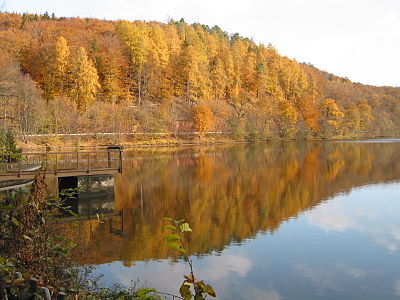autumn
The fall of one of the four meteorological and astronomical seasons , the season between summer and winter .
In the temperate zones , it is the time of harvest and leaf fall . In the autumn of the northern hemisphere , the sun appears to move from the celestial equator to the tropic of the tropics.
Astronomical autumn is here with the day and night are equally on 22 or 23 September, meteorological and biologically it is usually scheduled for early September. For the southern hemisphere the astronomical beginning is on 20./21. March.
Autumn ends astronomically on December 21st or 22nd in the northern hemisphere and on June 21st in the southern hemisphere ( winter solstice ).
Emergence
etymology
In terms of linguistic history, the word autumn has the same origin as the English word harvest “harvest (time)”, Latin carpere “pick” and Greek karpós “fruit, yield”, also Lithuanian kirpti “cut”, Greek krōpíon “sickle”. The word autumn originally meant “harvest time”. This agricultural significance was retained in English, while in German it shifted to the general designation of the season. In the south-west German-speaking area, the original meaning of the word as a dialect or technical term for (wine) reading lives on: this activity is widely referred to there as the bitterest . In the same area the season is called late year (as a mirror form of spring ).
Northern and southern autumn
Depending on whether autumn is in the southern or northern hemisphere , a distinction is made between southern autumn and northern autumn . Because of the wandering zenith of the sun between the southern and northern tropics , autumn is repeated in every hemisphere with an annual cycle . It is therefore also possible to deduce a northern spring from a southern autumn and vice versa.
Astronomically , it begins with the autumn equinox ; (one also speaks of the Equinox or the equinox of the day and night):
- in the Northern Hemisphere on September 22nd or 23rd ,
- in the southern hemisphere on March 20th or on the night of March 21st ,
- and ends with the winter solstice ( December 21st or 22nd in the northern hemisphere, or June 21st in the south)
Since the earth's orbit around the sun deviates from a circular orbit by 1.7 percent, the four seasons are not exactly the same length. This also has some effect on the phenological beginning of autumn, which can differ climatically from the astronomical. A distinction is also made between early autumn , full autumn and late autumn .
The months of September , October and November are approximated in the northern hemisphere and March , April and May in the southern hemisphere.
In autumn, the leaves on the trees change color before they fall off. The cause is the slow withdrawal of the sap into the trunk or roots . The chlorophyll is broken down and other leaf pigments ensure the bright color. These dyes are z. B. to carotenoids and anthocyanins . Some of them are already present in the leaf, some are newly formed, as is the case with the anthocyanins. The dyes have a protective function against sunlight, so that the juices present in the leaf can be transferred into the trunk before it finally falls off (see leaf fall ).
In autumn, the time is also changed from summer to normal in some countries around the world .
Fall Festivals
- Thanksgiving or Thanksgiving
- Oktoberfest
- Halloween
- Reformation day
- All Saints Day
- Martin's Day
- Sukkot , Jewish feast of tabernacles
Poetry
Hardly any other nature motif has been treated as often in poetry as autumn. One example is the poem Herbst by Rainer Maria Rilke .
gallery
Autumn from Arcimboldo
See also
Web links
Individual evidence
- ↑ Proof in dialect dictionaries
- ^ Rainer Maria Rilke: Autumn. In: Complete Works. Volumes 1–6 (= Complete Works. Volume 1). Wiesbaden and Frankfurt aM 1955–1966, p. 400. ( online )









